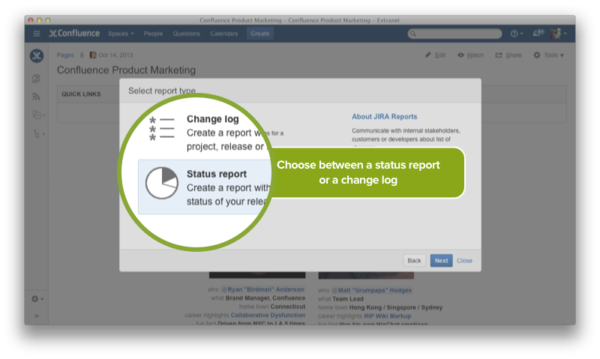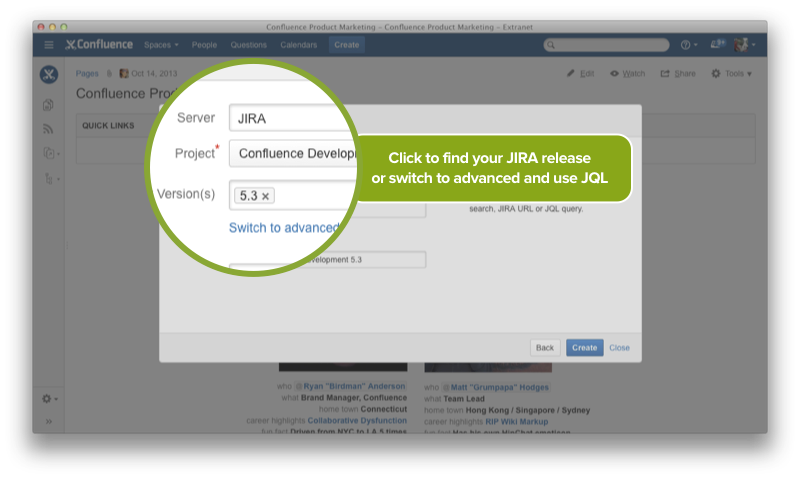One out of every two Confluence customers also uses Jira. Development teams live in Jira where they track their work; the rest of the business lives in Confluence where everyone collaborates around requirements, documentation, marketing plans, sales reports, and everything else.
You’ve told us you need an easy way communicate the work that your development team is completing in Jira to the teams and stakeholders that live in Confluence. We’re excited to announce that with the new Jira reports blueprints you can do just that, without ever leaving Confluence.
Publish project status and change log reports in Confluence
Two new Jira reports blueprints make it easy to communicate the status of your Jira releases to the rest of the business in Confluence. Create an ad-hoc status report that shows the progress of the current release, or a change log that displays what’s changed in your latest release.

![]()
Atlassian Inc.
1. Share Status Reports
Product managers and development team leads, this one’s for you. It’s never been this easy to answer the question, “Hey, where’s the current project at?” before anyone even asks.
Share a visual snapshot of your dev team’s progress
Create an ad-hoc report in Confluence of your latest release, and give stakeholders a snapshot of your development team’s progress in a matter of clicks. There’s no need to dig into Jira or manually gather data – just choose your Jira project and version. You can also use Jira Query Language (JQL) to show exactly what you want (and nothing you don’t).
The Status Report Blueprint makes it easy to provide context to your work, and gives you four Jira charts that you can customize or reconfigure before publishing in Confluence.
The reports show:
- Overall status of your issues
- Priority of your issues
- Component makeup of your issues
- Issue type makeup of your issues
These charts provide a visual snapshot of your release that’s quick to reference, and easy to understand. Reconfigure them if you want to show your stakeholders something different. To display these charts, the Status Report Blueprint makes use of the new Jira Macro, available on the Marketplace. You can use this macro to embed charts of Jira data on any Confluence page.
Confluence also automatically collects all of your Jira reports in one place on an index page, so they’re easy to find and access at any time.
2. Publish Change Logs
It’s also easy to share what’s changed in a recent release with the rest of the business.
Communicate what’s changed in your latest release
In a few clicks you can publish internal release notes so everyone is up to speed, even if they don’t have access to Jira. We do this for every Confluence release at Atlassian. Creating a change log follows the same process as a status report, but the finished report focuses on what’s changed:
Similarly, all change logs are stored alongside your other Jira reports in one place on an index page so they are always easy to find.
Start reporting today
Communicate the status of releases – and the changes between them – to the rest of the business in Confluence with the new Status Report Blueprint and Change Log Blueprint. Keeping key stakeholders informed has never been this easy.
Using OnDemand?
You’ve been auto-upgraded! If you are using Jira alongside Confluence, you can publish a change log or status report using the Create dialog in Confluence.
Using download?
If you are running Confluence 5.3 or later you can update the Confluence Software Blueprints Bundle and the Jira Macro via the Atlassian Marketplace to add all of the Jira Reports blueprint functionality to your Confluence instance.
